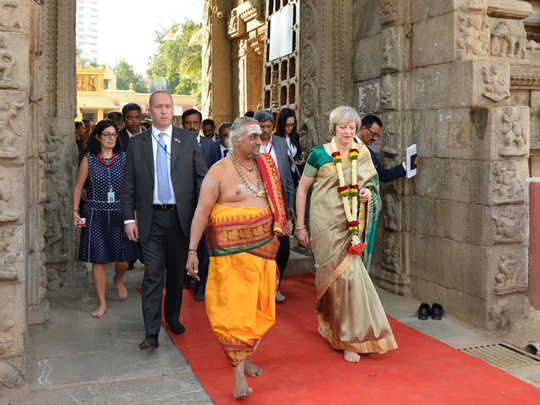
As British Prime Minister Theresa May arrived in New Delhi for talks with her Indian hosts last week, to forge closer trade and defence ties, she passed the massive arch of India Gate, the main war memorial to the Indian Army. The work of Sir Edwin Lutyens, it serves as a tribute to the phenomenal contribution that hundreds of thousands of Indian soldiers made to the British cause during the First World War. Stationed thousands of miles from home and forced to cope with alien terrain and climate, it is estimated around 65,000 Indian soldiers perished during a conflict that saw them play a vital role in reinforcing British positions on the Western Front.
The Indian Corps provided half the attacking force at the Battle of Neuve Chapelle in March 1915, while other units fought at the Second Battle of Ypres. Those wounded in the various battles of the Somme were sent to Brighton for medical treatment and the Hindus and Sikhs who died of their injuries were cremated on the South Downs at a site commemorated today by the Chattri war memorial.
The Second World War also saw Indian forces make a significant contribution to the Allied campaign against Nazi Germany, even though many of India’s leading politicians, such as Mahatma Gandhi, were interned for voicing opposition to the British war effort. Around 89,000 Indians lost their lives in that conflict. Thus, when May told Indian Prime Minister Narendra Modi of her desire to see closer cooperation between Britain and India on issues such as defence, cybersecurity and tackling the modern menace of terrorism, she was, in effect, seeking to revive an important historic alliance — one that has the potential to be as relevant today as it was during British Raj in India. There have, of course, been dramatic changes in the dynamics between the two countries.
The glory of Empire is but a distant memory and these days, Britain approaches its former colony more as a supplicant than as a major power that calls the shots. Recent cuts to the military and Foreign Office budgets, as well as the controversial legacy of Britain’s involvement in the recent conflicts in Iraq, Afghanistan and Libya, have created the perception that Britain is a nation in decline. India, on the other hand, is one of the few countries among the once-heralded Brics (Brazil, Russia, India, China and South Africa) bloc that enjoys sustainable growth and whose economic prospects are, in the main, positive.
The rapid economic growth India has enjoyed over the past decade has seen it close the gap dramatically on developed economies such as Britain. Ten years ago, British economy was three times the size of India’s. Today, the gap has shrunk to just 50 per cent. India’s increased wealth, moreover, has seen New Delhi upgrade its global ambitions, particularly in the defence sphere, where Modi is committed to building the country’s military capabilities, while transforming it from being the world’s largest arms importer into a heavyweight manufacturer.
And, in the post-Brexit world, reviving the long-standing military links between Britain and India could help to redefine Britain’s position on the world stage, as well as offering lucrative business opportunities. At a time when a lack of effective leadership within the western alliance threatens the future of established organised institutions such as Nato and the European Union, this is an opportune moment for Britain to think about establishing a new set of alliances beyond its traditional comfort zone. This is, after all, a pattern that can be seen in other parts of the world as well.
China’s economic growth has seen it establish a network of alliances that stretches from its local sphere of influence among the Asean (Association of Southeast Asian Nations) alliance to countries like Djibouti in the Horn of Africa, where Beijing’s plans to establish a military base threaten the future operation of America’s main intelligence-gathering base for Africa and the Middle East.
Russia, too, has been busy building alliances in eastern Europe, Central Asia and the Middle East. Nato — assuming it survives in its current form — will remain a vital element in Britain’s defence outlook. But as a maritime nation, it makes sense for Britain to look further afield, and forging closer defence ties with countries like India is smart diplomacy on so many levels. Indian defence spending is set to equal that of Britain in the coming decade, and cooperating with a friendly, democratic country that poses real military clout could prove invaluable in tackling future threats.
The Anzac alliance between Australia and New Zealand is another area where Britain should look to deepen its defence ties. Anzac forces distinguished themselves in the recent conflicts in Iraq and Afghanistan, often proving to be more effective than established Nato allies such as the Italians and Germans. We now live in an age when traditional alliances may not be as reliable as they were. This is why it makes sense to strengthen old friendships that could prove vital in keeping the peace in the decades to come.
— The Telegraph Group Limited, London, 2016
Con Coughlin is the Telegraph’s defence editor and chief foreign affairs columnist.









